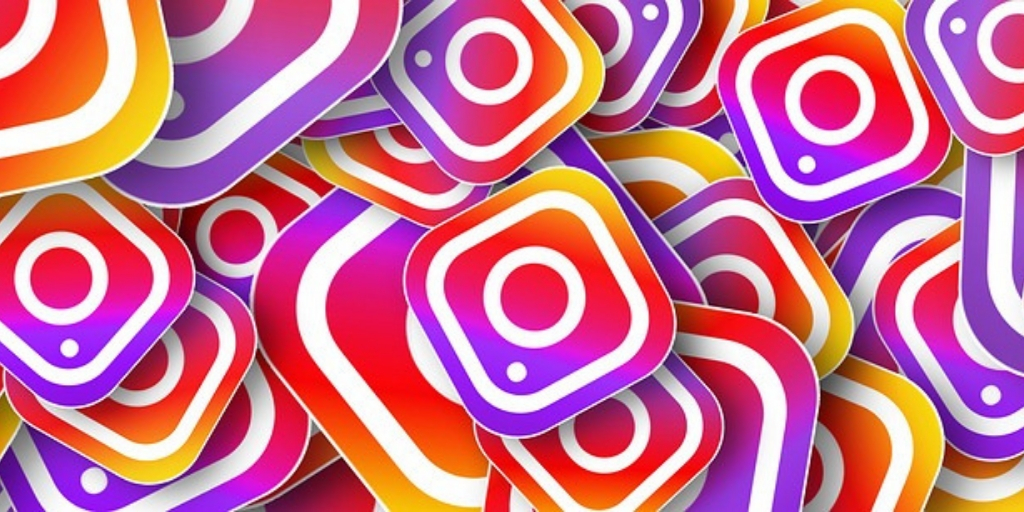
by Fronetics | Feb 19, 2019 | Marketing, Social Media
Need some Instagram for B2B marketing inspiration? These 10 brands are getting it right.
Highlights
- Instagram is a great opportunity for B2B businesses.
- Avoiding blatant sales or advertising pushes is key.
- Successful accounts engage users with interesting visuals and/or provide them with value through informative content.
Instagramnow boasts over 1 billion monthly active users, making it one of the most popular social media platforms out there. It’s a tremendous opportunity for businesses. In fact, recent research has shownthat 66% of brands now use Instagram.
But many B2B marketers are still struggling to find their footing on this highly visual platform. Since we could all use a little inspiration now and then, here are 10 brands that are crushing Instagram for B2B marketing — and what we like about their presence.
10 brands that are nailing Instagram for B2B marketing
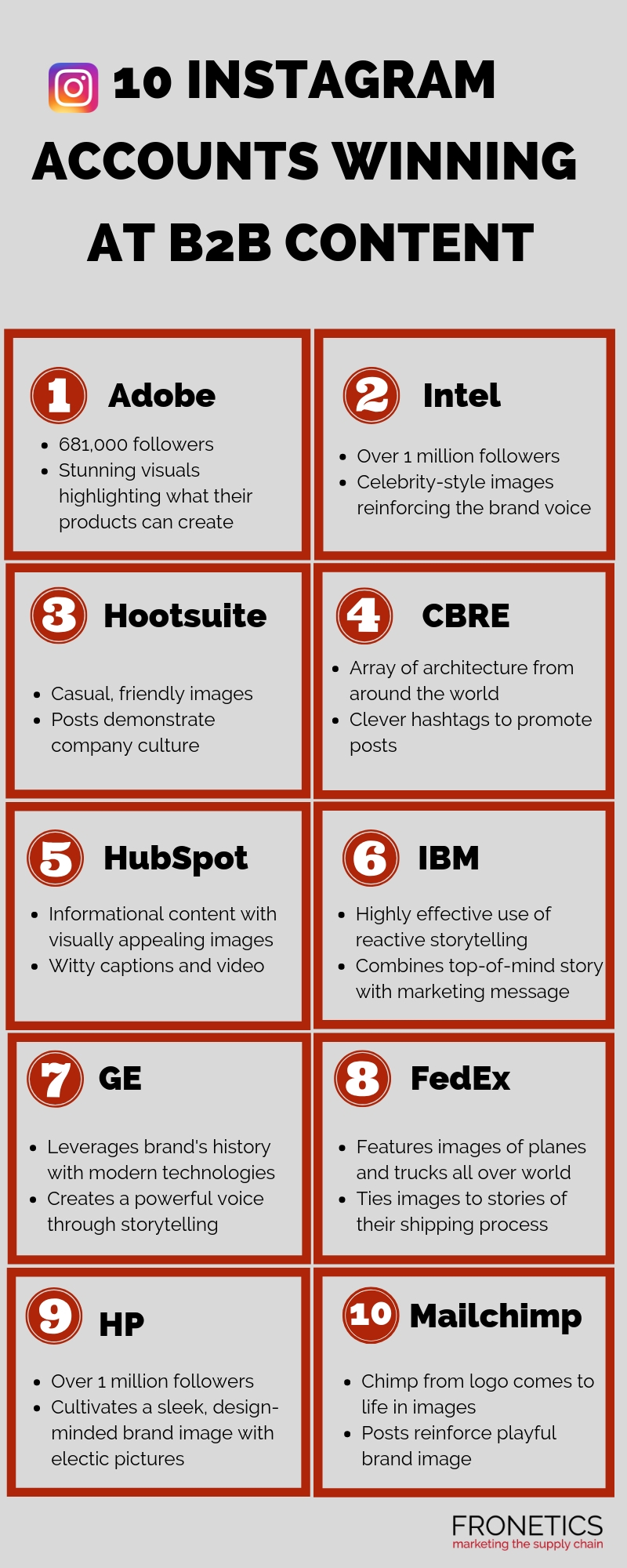
(Made with Canva)
1) Adobe
With 681k followers, Adobe (@adobe) is a fortunate brand when it comes to Instagram in that its product naturally lends itself to the visual medium. Its account boasts some truly stunning visuals, highlighting what Adobe products can create.
2) Intel
The tech giant Intel (@intel) cultivates a celebrity-style image, giving its over-a-million followers an inside glimpse into big events the brand plays a role in, like the X Games, Grammys, and glitzy tech conferences. Each of the carefully curated images reinforces the brand’s voice, and captions do a great job of detailing exactly what the brand does in the tech space.
3) Hootsuite
Social media management dashboard Hootsuite (@hootsuite) does a fantastic job of showing brands their social media know-how, right in its Instagram profile. The company cultivates a casual, friendly image and posts content that demonstrates company culture. From team building photos to office dogs, Hootsuite makes followers feel like they’re getting to know the brand.
4) CBRE
Global commercial real estate firm CBRE (@cbre) is a phenomenal example of finding beauty within the context of its operations. The brand’s Instagram feed features a stunning array of architecture from around the world, with clever use of hashtags.
5) HubSpot
Here’s a company getting content Instagram for B2B marketing right. HubSpot (@hubspot) consistently provides value to followers, posting informational content. Rather than letting it get boring, the brand keeps content visually appealing and makes clever use of captioning and video.
6) IBM
Tech juggernaut IBM (@ibm) has made highly effective use of reactive storytelling on Instagram. This method of storytelling combines a top-of-mind story or idea with a compelling marketing message. IBM uses it during popular or inspiring events, demonstrating how it’s making use of the brand’s technology.
7) General Electric
It’s a household name brand, and it’s over a century old. General Electric’s (@generalelectric) Instagram presences does a great job of leveraging the brand’s history, highlighting its involvement with important developments in defense, aviation, and technology. It’s a great example of creating a powerful voice from a brand through storytelling and tapping into the audience’s nostalgia.
8) FedEx
FedEx (@fedex) is a prime example of a B2B brand that makes the absolute most of what it does to create a compelling story for its Instagram content. The account features photos of airplanes and trucks all over the world, telling the story of how the carrier cares for and ships products in its care.
9) HP
With over a million followers HP (@hp) cultivates a sleek, design-minded brand image on Instagram. It capitalizes on subtlety and style, with eclectic images that never feel overtly promotional but that highlight the brand’s innovation.
10) Mailchimp
Email marketing company Mailchimp (@mailchip) truly gets the most out of its whimsical logo. Its Instagram content has given the playful chimp logo life and transformed him into a personality and voice for the brand. The image is quirky and fun, and Mailchimp’s Instagram presence reinforces and capitalizes on that.
What companies do you think are doing Instagram for B2B marketing right?
Related posts:
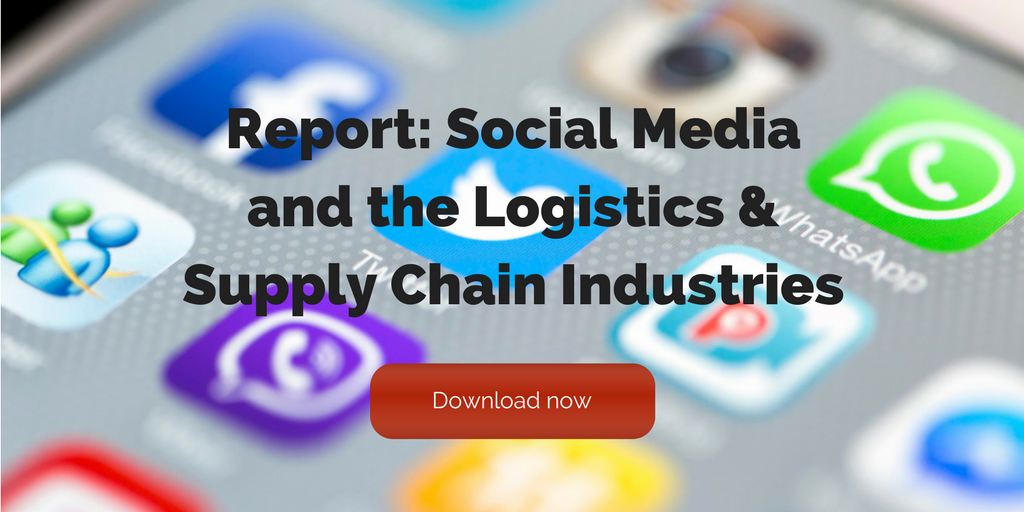
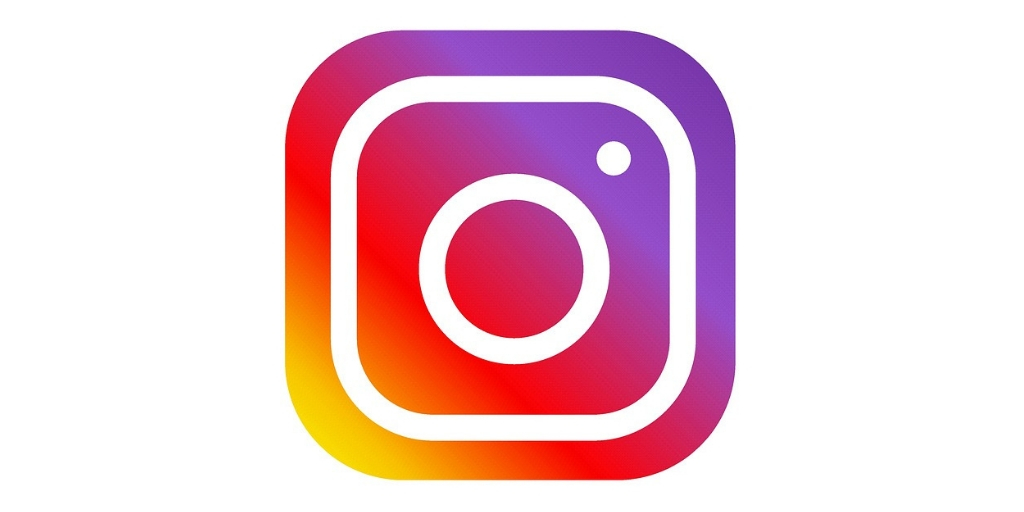
by Fronetics | Feb 7, 2019 | Blog, Content Marketing, Logistics, Marketing, Social Media, Supply Chain
Looking to boost followers on Instagram? These tips will help supply chain marketers grow their following, build brand awareness, and nurture a loyal audience base.
Highlights
- Instagram has over 500 million daily users.
- Fake accounts won’t help in the long run.
- Growing authentic followers requires commitment and strategy.
While it’s true that Facebook is a favorite for B2B marketing, don’t overlook Instagram. Over 500 million users browse the app daily — some of the most engaged audiences on the web. This is absolutely a powerful resource for supply chain marketers, and if you aren’t already, it’s time you start tapping into it.
But as with all social media platforms, there’s a right and a wrong way to go about using it. When it comes to Instagram, getting the most out of the platform has a lot to do with boosting followership.
Keep in mind that recent studies have shown that roughly 48 million Instagram users are fake. Inflating your audience with fake followers won’t serve you well.
Boosting engagement and growing your following takes time and strategy. The 10 tips in our infographic below will help you get the most out of Instagram, building an authentic, engaged audience.
10 tips to boost followers on Instagram
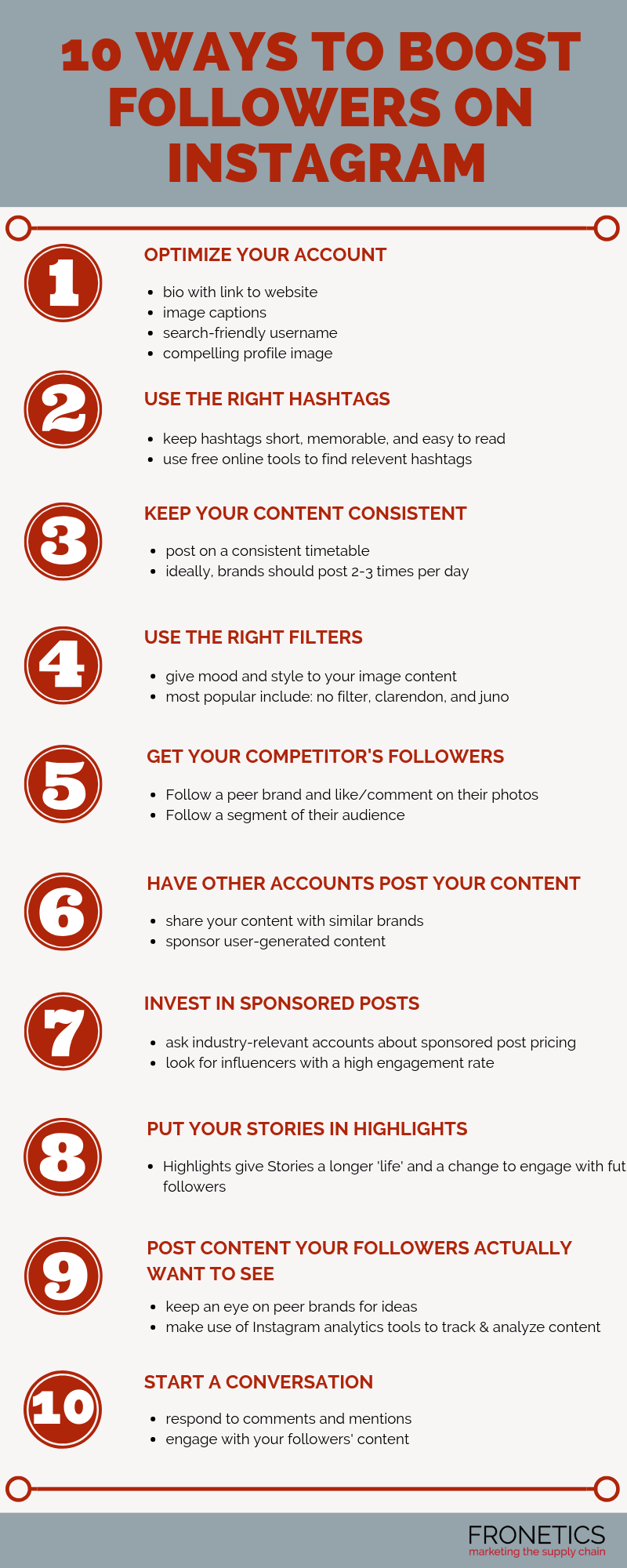
(Made with Canva)
1) Optimize your account
Before we get to anything fancy, take a step back and make sure your Instagram account is fully optimized. This means you need:
- a bio with a link to marketing or product pages related to a specific keyword or hashtag
- image captions, which can reference the link in your bio
- a search-friendly username
- a compelling profile image that reflects your brand
2) Use the right hashtags
One of the most effective ways to grow your Instagram following is to use hashtags effectively. Since Instagram gives users the ability to follow hashtags that interest them, and they function as links to other relevant content, choosing the right hashtags is the ideal way to reach and engage your target audience.
Keep an eye on accounts of peer brands to stay up to date with the best hashtags to be using. The most effective hashtags are short, memorable, and easy to read. You can also use a free online tool like InconoSquare or Websta to find relevant hashtags for the supply chain and logistics industries.
3) Keep your content consistent
Posting on a consistent timetable is crucial to maintaining an active following. Posting irregularly means you risk your followers forgetting about you. And posting all at once can annoy and drive followers away. Ideally, brands should post 2-3 times a day. For more, check out our guide to when to post on social media.
4) Use the right filters
We all know that playing with filters is fun. These lighting and color presets offered by Instagram have the potential to create mood and style in your image content. According to Iconosquare, these 10 filters are currently the most popular on Instagram. And it turns out that the filters you choose really do have an impact on engagement.
- Normal (No Filter)
- Clarendon
- Juno
- Lark
- Ludwig
- Gingham
- Valencia
- X-Pro II
- Lo-fi
- Amaro
5) Get your competitors’ followers
Maybe it sounds like a dirty trick, but hear us out! Users who have already shown an interest in similar brands to yours are an ideal audience base. Engaging with them is a great way to grow your own following. Identify a peer brand with a healthy Instagram following; follow a segment of their audience; and like or comment on their photos. Keep track of how many users follow your brand back.
6) Have other accounts post your content
Operating on the principle that followers of similar accounts to yours are an ideal audience base, getting these accounts to post your content is a great way to boost your followership. One way to do this is to sponsor user-generated content to get your brand in customers’ feeds. For example, hold a photo contest related to your brand, encouraging followers to post and caption your content.
7) Invest in sponsored posts and product reviews
Optimizing your account and following Instagram best practices will go a long way toward getting authentic followers. But to really boost your followers on Instagram, it pays to take advantage of influencer marketing on Instagram. Create a list of large accounts in your industry, follow them, reach out to their marketing team, and ask about sponsored post pricing. Be on the lookout for influencers with a high engagement rate relative to number of followers.
8) Put your Stories in Highlights
In addition to its Stories feature, Instagram now lets users create a featured group of “Highlights” in various categories on their profile. Stories have only a 24-hour lifespan, so featuring your most effective Stories clips in Highlights gives them a second life and a chance to engage future followers. One of the best features of Stories and Highlights is that they allow brands to view and analyze how users have viewed and interacted with their content.
9) Post content your followers actually want to see
This one may sound painfully obvious, but it’s harder than it looks. Because brands need to publish content consistently to maintain an active Instagram following, it can be extremely difficult to generate fresh, interesting content consistently. There’s no easy trick to this one. Keep an eye on peer brands, and make use of Instagram analytics tools to track, analyze, and benchmark Instagram content.
10) Start a conversation
It’s easy to forget that the fundamental benefit of social media is that it’s social. Users want to be part of a conversation. Encourage your followers to interact with you on all your social media platforms, including Instagram. This means responding to comments and brand mentions, as well as engaging with your followers’ content.
Final thoughts
Instagram is an extremely effective tool for supply chain marketers. These 10 tips to boost followers on Instagram will help you create and nurture a loyal, engaged audience base. In turn, an effective Instagram presence has the potential to grow brand awareness, improve your reputation, and generate qualified leads.
Related posts:


by Fronetics | Feb 6, 2019 | Blog
Digital marketing has become essential to creating brand awareness, educating audiences and building credibility with customers. Here are the latest trends for 2019.
Highlights:
- Digital marketing has become essential to creating brand awareness, educating audiences and building credibility and trust with customers.
- Video is currently the most popular form of content being consumed online today.
- Peers and colleagues are the third most influential source of information for business to business (B2B) purchasing, right behind online searches and your website.
Video transcript:
Hi I’m Stacia Pathiakis. I’m an account manager at Fronetics and today I’ll going to be talking to you about six trends in digital marketing for the supply chain in 2019.
Digital marketing has become essential for creating brand awareness, educating audiences and building trust and credibility with your customers. Supply chain and logistics companies increasingly see the value in digital marketing. They’re increasing their budgets and it’s important to understand what the trends are for the upcoming year.
Here are six trends to consider when planning your 2019 strategy.
First, video. Video is currently the most popular form of content being consumed online today, and video marketing will continue to add substantial value in the upcoming year. Use video to teach your audience something that is worthwhile for them to know.
- Chatbots. Chatbots are automated messaging apps that simulate human conversation. They’ve become more popular in the past year than social networks.
- Voice search. Voice search is becoming an increasingly prevalent. It’s a means for people to search for the content they’re looking for using voice recognition. A good content marketing strategy should consider how your customers will be using voice search for information about in your industry.
Next is long-form content. Long form content includes such things as white papers, case studies, and longer form blog posts. Many industries, including supply chain and logistics industries, are saturated with short form content. Long form content provides a means of getting more in-depth information to your customers.
- Brand ambassadors. Peers and colleagues are the third most influential source of information for business to business (B2B) purchasing. And there’s nothing more credible than a friend who speaks highly of their company’s services and products.
- Market influencers. Market influencers is a form of marketing that focuses on individuals rather than the market as a whole. Basically, marketers identify individuals who would have influence over a larger group and target them specifically in their digital marketing campaign.
The beginning of the year is a great time to review your marketing strategy to make any changes for the upcoming year. For more tips on boosting your digital marketing strategy in 2019, visit us at fronetics.com.
Related posts:
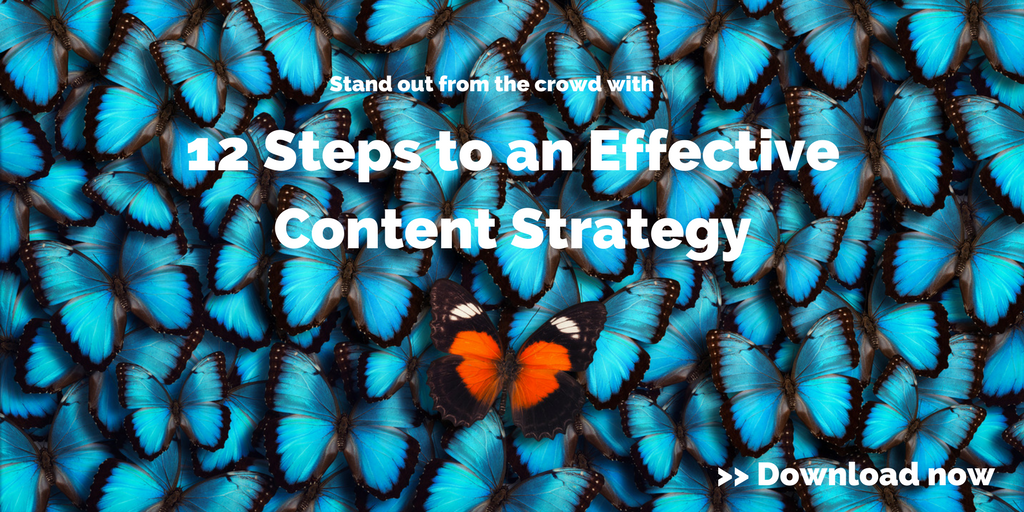
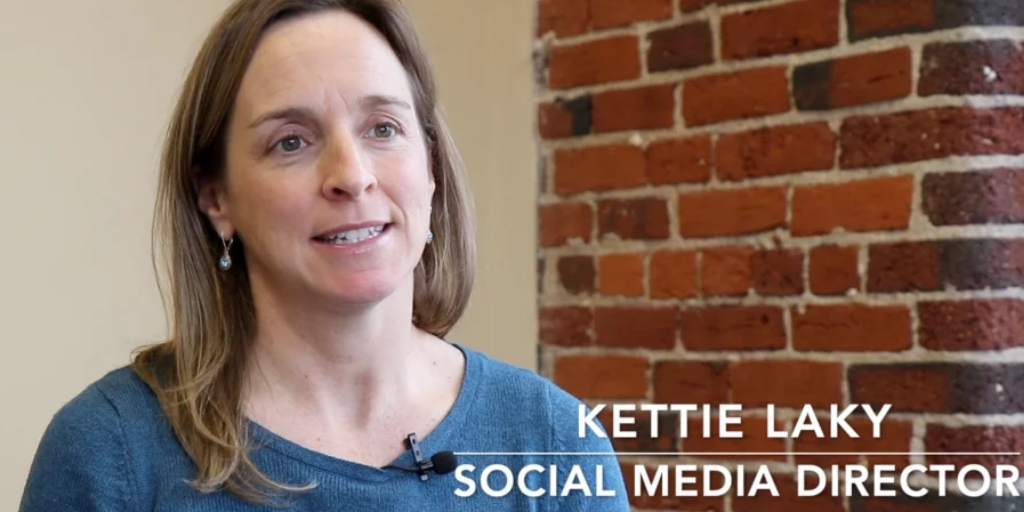
by Fronetics | Jan 22, 2019 | Blog, Content Marketing, Logistics, Marketing, Social Media, Supply Chain
Social media is an ideal way for supply chain and logistics companies to reach their audience. But too many businesses are still making these basic social media mistakes.
Highlights
- Social media only works as a marketing tool if you have a documented strategy.
- Don’t try to use every popular platform. Find where your target audience spends their time and focus on that platform.
- Don’t promote your brand. Engage with customers to build long-lasting relationships.
Video transcript:
I’m Kettie Laky. I’m the director of social media at Fronetics, and today we’re going to be talking about the basic mistakes that companies still make with social media.
As of 2019, there are approximately 2.8 billion social media users around the globe. So there’s no denying social media is a powerful tool for businesses to create brand awareness and generate leads. But it’s not going to be effective if it’s not done correctly.
There are three mistakes that businesses tend to make on social media still.
The first one is using objectives instead of strategy to drive their social media. Social media platforms are making updates and changes all the time to improve the customer experience. To weather those changes and to keep your customers engaged, it’s important that you have a strategy behind what you’re doing. The strategy should include content, the frequency of posts, and pillar content. A strategy’s also going to help you prove ROI.
The second mistake that companies tend to make is using all the most popular social media platforms. Social media platforms have differentiating qualities that appeal to different audiences. So get to know where your audiences are spending their time. For instance, if you’re marketing to millennials, you’re going to want to be on Twitter.
The third mistake companies tend to make on social media is by promoting rather than engaging. The companies that are having success with social media are finding innovative and creative ways to relate to their customers. So get your customers engaged, get them involved in your story, and you’re going to create long-lasting relationships with them.
If you need help with your social media strategy, give us a call or visit us at Fronetics.com.
Related posts:


by Fronetics | Dec 11, 2018 | Blog, Content Marketing, Logistics, Marketing, Supply Chain
Our most-viewed content marketing posts indicate that marketers are seeking solutions to improve their content marketing programs.
Supply chain and logistics marketers have seen the benefits (and successes) of content marketing. It is the most cost-effective method to earn leads and sales. Why? Because content marketing focuses on the way B2B byers are making purchases, finding and evaluating content through online searches.
[bctt tweet=”Content marketing focuses on the way B2B byers are making purchases, finding and evaluating content through online searches.” username=”Fronetics”]
There is a trend with our most-viewed content marketing posts this year: innovative ways to improve content marketing strategies. From increasing brand awareness to improving SEO, marketers are looking to get their content in front of the right audiences.
Here’s a look at our top content marketing posts from this past year, all focused on industry trends and ways to improve your content marketing strategy.
Top 10 content marketing posts in 2018
1. B2B Marketing Trend 2018: Influencer Marketing
You’ve probably heard the buzzword by now: Influencer marketing seems to be on the tip of every marketer’s tongue these days. But the reality is that B2B marketers have been slow to adopt this new marketing trend. Influence 2.0 – The Future of Influencer Marketing Research Report 2017 showed that only 11% of B2B marketers have an ongoing influencer program. Read full post
2. Writing for SEO: Topic Clusters and Pillar Content (NOT Keywords)
I’ve been hinting — more like, emphasizing — in our recent Writing for SEO series that trying to rank for certain keywords in each blog post you publish is a practice on the way out. You may have been wondering what you’re supposed to do instead. This post on topic clusters and pillar content is your answer. Read full post
3. 10 Ways to Grow Brand Awareness Quickly
If you took Psychology 101 in school (or even if you didn’t), you know that people are more likely to buy from brand names they’re familiar with than those they don’t know. This goes for purchasing things like medicine, and for procuring components or parts as part of the supply chain. That’s why so many of our clients come to us looking to build brand awareness as one of their main goals. They want to customers to know about them — and sooner rather than later. Read full post
4. Should Your Business Be Using Linkless Backlinks to Increase SEO?
Linkless backlinks are mentions of your business or brand without a hyperlink to your webpage. In a keynote speech in September 2017, Gary Illyes, a webmaster trend analyst for Google, said:
“Basically, if you publish high-quality content that is highly cited on the internet — and I’m not talking about just links, but also mentions on social networks and people talking about your branding — then you are doing great.” Here’s how to make linkless backlinks work for you. Read full post
5. Writing for SEO: People Are Changing How They Search
Last week, we kicked off our Writing for SEO series by taking a look at how search engines are changing. As we delve further into updated strategies for effective SEO writing for supply chain marketers, this post explores the ways in which people are changing their search behaviors, and what that means for your content. Read full post
6. 3 Questions to Ensure your Content Marketing Strategy Is Sales-Focused
I recently read an article on the Harvard Business Review that discussed pairing your sales goals with your marketing goals. This strikes at the heart of what we do at Fronetics: build a client’s content marketing strategy that will help advance their short- and long-term business goals. It sounds simple, but you have no idea how many organizations’ marketing goals are misaligned with what the larger organization is trying to accomplish. Read full post
7. Infographic: 8 Ways to Grow Brand Awareness Fast
Have you ever noticed how some brands seem to have crept into popularity overnight? You’ve never heard of them, and then, all of sudden, they’re everywhere. Their brand awareness has sky rocketed, and they’re achieving every company’s ultimate goal: Customers know about them. So what’s their secret? Read full post
8. The More Often You Publish Blog Content, the More Leads You’ll Get
Here are Fronetics, most of our clients are sales-driven. If a client’s business goals include earning leads, we are sure to align the client’s content strategy with that objective. One of the most effective ways to increase the number of leads your website attracts is to increase the frequency with which you publish content. Read full post
9. How to Identify Topic Clusters for Your Business
One of the best ways to strategically structure your content is with the topic cluster model, in which broad cornerstone content is contained on pillar pages, and related subtopics are contained in cluster content. Each grouping of subtopics and corresponding pillar page is called a topic cluster. This structure is intended to build authority and influence for your business in the eyes of search engines and visitors. Effectively using a topic cluster structure is the best way to drive relevant traffic to your website. Read full post
10. Video: Why Does Content Marketing Take So Dang Long to Show Results?
You are committed to your content marketing program. You’ve created blog posts, uploaded videos, and collaborated with industry leaders. You may have started noticing an increase in web traffic, social reach, and other engagement metrics like time on page. You’re on the right track! The problem is your lack of leads or sales. Your boss is pressuring you for results, and you’re starting to question your efforts. Are you doing something wrong? Read full post
Related posts:










